It was hard to imagine just how much drama remained in the first phase of the tournament following our initial report.
The scramble to earn a place in the top four and to qualify for the semi-finals brought out the best – and worst – out of the world’s finest players.
Phase One – Final Scores
The final scores of the first phase reveal a clear split between the top half and the bottom.
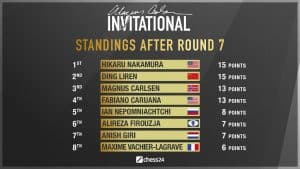
Hikaru Nakamura, Ding Liren, Magnus Carlsen and Fabiano Caruana are clearly worthy qualifiers for the semi-final matches, but despite the gap between the qualifiers and the chasing pack nobody has enjoyed an easy tournament.
Some of the games had to be seen to be believed. Of course, playing chess for high stakes from their own homes will be a strange experience for the players and to be even slightly off form in such company is always going to lead to frustration, but even so there have been curious errors and massive swings in the advantage, often perpetrated by a single move.
Fluctuating Form
Magnus Carlsen’s form continues to fluctuate. His first game after losing his match to Giri saw an unsuccessful opening experiment. Playing White against Ian Nepomniachtchi, Carlsen appeared to be trying to save a move on Bobby Fischer’s old favourite, the Sozin Variation (1 e4 c5 2 Nf3 d6 3 d4 cxd4 4 Nxd4 Nf6 5 Nc3 a6 6 Bc4) but the plan backfired. 1 e4 c5 2 Nf3 d6 3 d4 cxd4 4 Nxd4 5 Bc4 Nxe4 6 Qh5 e6 7 Nxe6 and Nepomniachtchi found the refutation with 7 …Bxe6 8 Bxe6 Qe7, forcing the champion to make the best of a bad job with 9 Bxf7+ Qxf7 10 Qe2, which certainly did not give anywhere near enough compensation for the lost piece (0-1, 28).
Carlsen had tried the same order of moves against Maxime Vachier-Lagrave but the e-pawn gift had gone unclaimed; the latter kept it solid in the opening with 5 …e6 (the game was drawn after 51 moves.) Nepomniachtchi had presumably taken a good look at 5 Bc4 and decided there was nothing to fear after 5 …Nxe4.
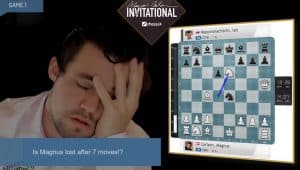
The second game of the match brought another experiment from the champion, with a rare outing for the Nimzowitsch Defence (1 e4 Nc6) and a wild game in which, it could be said, both players were fortunate to earn a draw.
Carlsen did go on to level the match but was only able to finally shake off his tough opponent in the Armageddon game, in which he had the white pieces and had to win. He managed to do so only after a lengthy and extremely close battle, with both players virtually down to thin air on the clocks.
Tricky Armageddon Ending
It is notoriously difficult to win with knight and pawn against bishop. It is obvious that if the defending side isn’t going to fall for a simple fork then the knight needs to block the bishop’s path in order to march the pawn forward to promotion.
I remember reaching this endgame for the first time back in the 1980s and thinking it would be a relatively straightforward task. However, I found out the hard way that a skilled defender can hold a lot of positions just by knowing where the king and bishop need to be. Although I did eventually manage to safely queen the pawn it was only because my opponent and I became extremely short of time and his bishop ended up slipping to the wrong square by a reflex action.
This scenario was repeated in Carlsen – Nepomniachtchi, with the latter making a fatal slip just when the cherished draw was in sight.
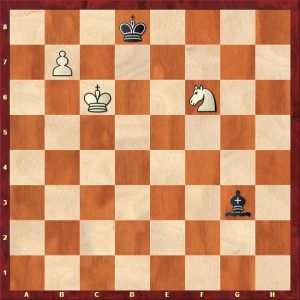
Carlsen – Nepomniachtchi
Armageddon Game
Black has been holding very well so far. White has made as much progress as possible but still lacks a way to block the bishop from the queening square. Now 76 …Bh2 was a correct waiting move, but after 77 Ne4 reflexes must have taken over, as Nepomniachtchi played 77 …Bb8? The temptation is clear to see; White was apparently threatening 78 Nc5, to block the bishop. However, another cool defensive move was required, in the form of 77 …Ke7! This is counter-intuitive as it appears to move the king away from the action, but it protects the d6 square again and disarms the Nd6 plan. After the game move, 78 Nc5 brings White everything he wants. Black played 79 …Bh2 but all was lost after 80 Ne6+ with 81 Nc7 to follow. The only alternative was head for the other diagonal with 79 …Ba7. Unfortunately it is now a simple task to dominate the critical dark squares around the queening square. A sample line runs 80 Na6 Ke7 81 Kc7 Ke8 82 Kc8 Ke7 83 Nc7 Kf6 84 Nb5 and the bishop has been dominated.
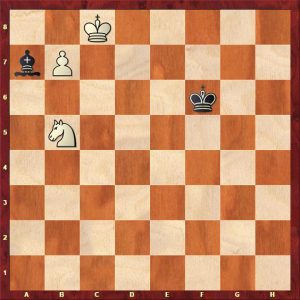
Incidentally, anyone interested in increasing their understanding of endings should try our course on 100 Endgames You Must Know.
Extraordinary Play
The major talking points of the concluding matches of the first phase all came from Carlsen’s games, featuring incidents which overshadowed Nakamura’s brace of excellent Armageddon victories over Ding and Vachier-Lagrave respectively.
Cast your mind back to 1993. When Garry Kasparov defeated Nigel Short to defend his PCA World Chess Championship title he needed just 20 of the scheduled 24 games. That is no slight on Short, who played very well and certainly had his chances; ultimately, he was simply outgunned. The extra time was used for exhibition games. To spice things up, a couple of the games used openings ‘drawn from the hat’ and in one of them Kasparov drew what was undoubtedly a short straw when he had to play the Black side of the Bryan Countergambit against White’s King’s Gambit, which starts: 1 e4 e5 2 f4 exf4 3 Bc4 Qh4+ 4 Kf1 b5.
Kasparov was far from happy with this and his mood may have contributed to his grisly defeat in just 15 moves.
The point is that Kasparov always takes every game he plays very seriously. Apart from his personal pride, there is also the underlying responsibility of being a World Champion.
Contrast Kasparov’s attitude with being lumbered with a clearly inferior opening with Carlsen’s experiments of this week. Was he experimenting a little too much?
Curious Opening Choices
He took the liberty of repeating his experiment with the unpopular Nimzowitsch Defence in his first game against Ding and it is fair to say the game did not go at all well for Black.
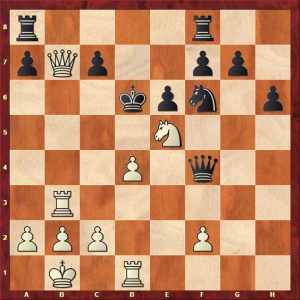
Ding – Carlsen
Game One
This is absolutely not the sort of final position we are used to seeing in Carlsen’s games. Test your own powers by a checkmate in five moves.
He took revenge in the second game with another unconventional opening – an anti-Sicilian with 1 e4 c5 2 f4 – but there was a bizarre start to the third game when he played 1 e4 c5 2 Nf3 Nc6 3 Bb5 h5 Things went from bad to worse and he lost in 27 moves.
The fourth round brought no respite. Carlsen, needing a win to force an Armageddon play-off, unleashed the King’s Gambit. Ding didn’t play the Bryan Countergambit – which would have brought this little piece nicely full circle – but took advantage of further weak play to record another devastating victory, in just 23 moves. This sealed a remarkable 3-1 match victory over the World Champion.
Unanswered Questions
There are lots of unanswered questions as we head towards the semi-finals.
Is Carlsen jaded and off form? Has he just been experimenting because he had already qualified for the semi-finals – and will he now return to sounder openings, allowing him to play more to his own strengths? Is he feeling the extra pressure in his dual role as both organsier and player?
It will be interesting to see how he plays in the next stage of the tournament.
Semi-final Pairings
The semi-final pairings are:
Nakamura – Caruana
Ding – Carlsen
Our concluding report will follow after the final.







